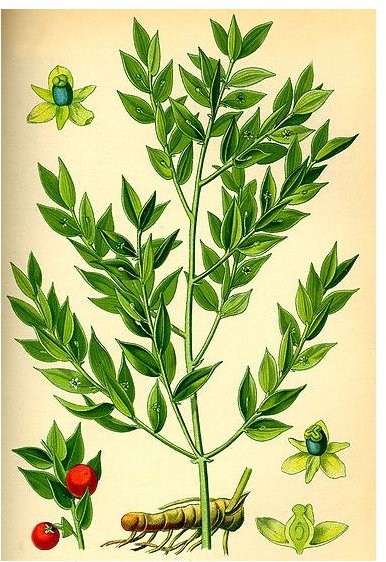Health Benefits of Butcher's Broom Herb
Butcher’s Broom
Butcher’s broom (Ruscus aculeatus) is known by many other names, including sweet broom, Jew’s myrtle, box holly, and knee holly. It is a low evergreen shrub that is native to Southern Europe, Africa, the Mediterranean, and the Middle East. It got its name butcher’s broom because the plant was once used by European butchers to clean their chopping blocks.
The plant, part of the lily family, has tough green stems and very rigid leaves. In the early spring, small greenish-white flowers appear. The fertile flowers are followed by red berries, about the size of large cherries, which ripen in September and remain all winter.
Health Benefits
The following are health benefits of butcher’s broom:
Venous Disorders
Butcher’s broom herb has a long history of use in treating venous disorders. Its active ingredients are ruscogenins. These compounds have anti-inflammatory and vasoconstrictor effects that are believed to improve the tone of veins. Butcher’s broom extracts are used extensively (internally and externally) in Europe to treat varicose veins and hemorrhoids.
Blood Circulation
Butcher’s broom is said to enhance blood flow to the legs, hands, and brain.
Orthostatic Hypotension
Orthostatic hypotension (also known as postural hypotension) is a condition where one’s blood pressure drops when arising from a seated or lying position. Chronic orthostatic hypotension can be a severely debilitating disease in the elderly, in people with diabetes, fatigue syndrome, and Parkinson’s disease, and in people who take medications that affect the autonomic nervous system.
Because this herb has venotonic and vasoconstrictive action properties, butcher’s broom shows much promise in relieving symptoms of orthostatic hypotension. However, more research is needed.
Laxative and Mild Diuretic
European doctors have also used butcher’s broom for centuries to treat constipation and rid the body of excess fluid.
Preparations
Extracts standardized to contain 9-11% ruscogenin (100 milligrams 3 times a day) are used to treat varicose veins, usually in combination with hesperidin (a bioflavonoid) and vitamin C.
Suppositories or ointments are normally used to treat hemorrhoids.
To prepare a cup of tea, pour 1 cup of boiling water over 1 teaspoon of dried herb (chopped root), cover, steep for 10 minutes, and strain.
Side Effects
Side effects from butcher’s broom herb are rare but may include nausea.
People with high blood pressure, women who are pregnant or breastfeeding, and young children should avoid taking. Individuals with a medical condition or taking medications should consult with their health care provider before taking.
Sources Used
Butchers Broom Benefits and Information: https://www.nutrasanus.com/butchers-broom.html
Michael Murray, N.D. and Joseph Pizzorno, N.D. Encyclopedia of Natural Medicine (1998)
Ruscus aculeatus (butcher’s broom) as a potential treatment for orthostatic hypotension, with a case report: https://www.ncbi.nlm.nih.gov/pubmed/11152059
Photo Credit
Image in the public domain.
Disclaimer
Please read this disclaimer regarding the information contained within this article.
